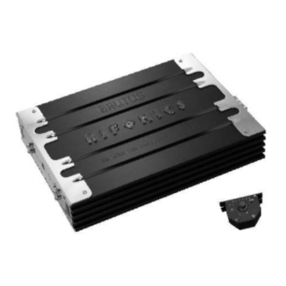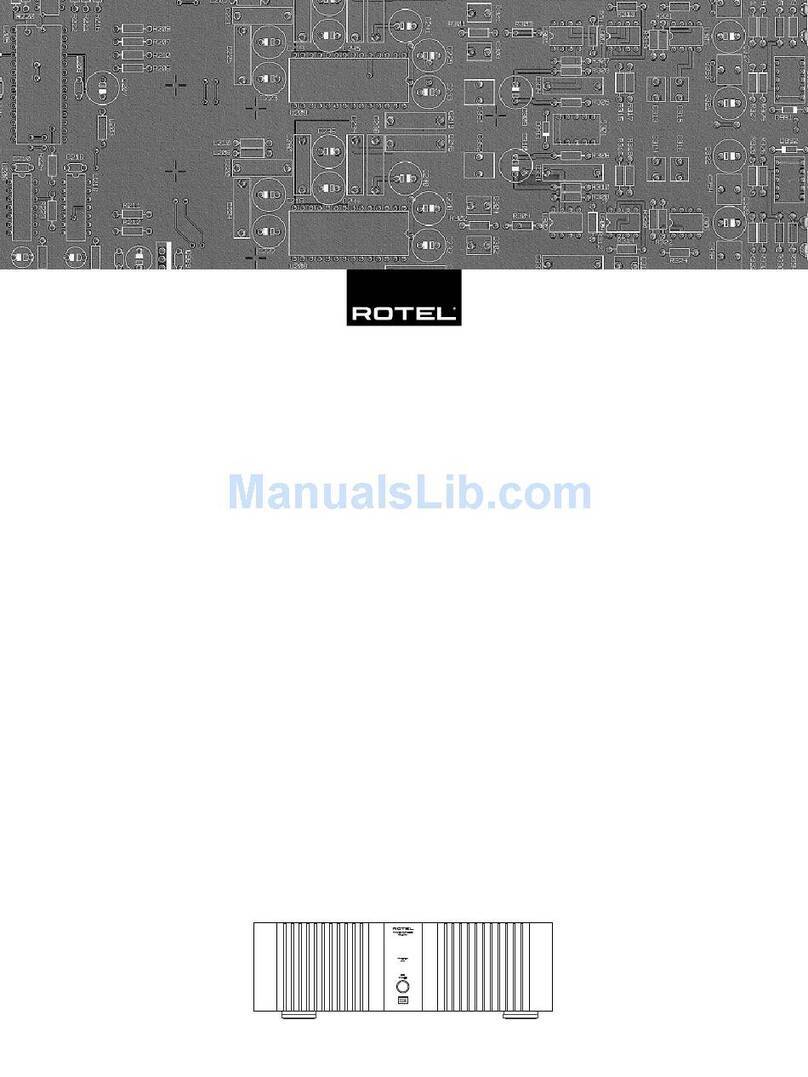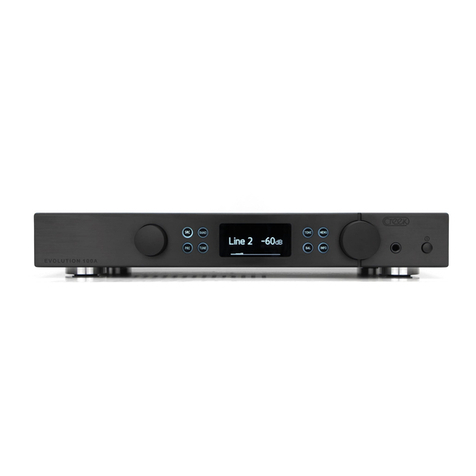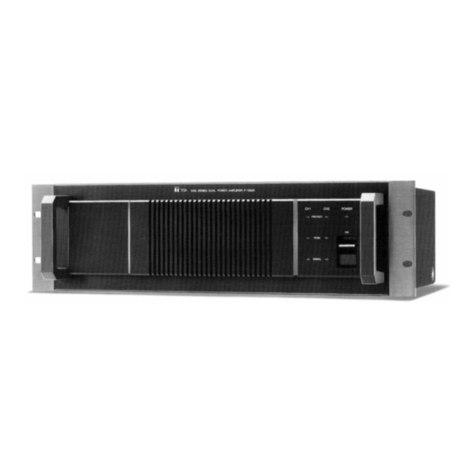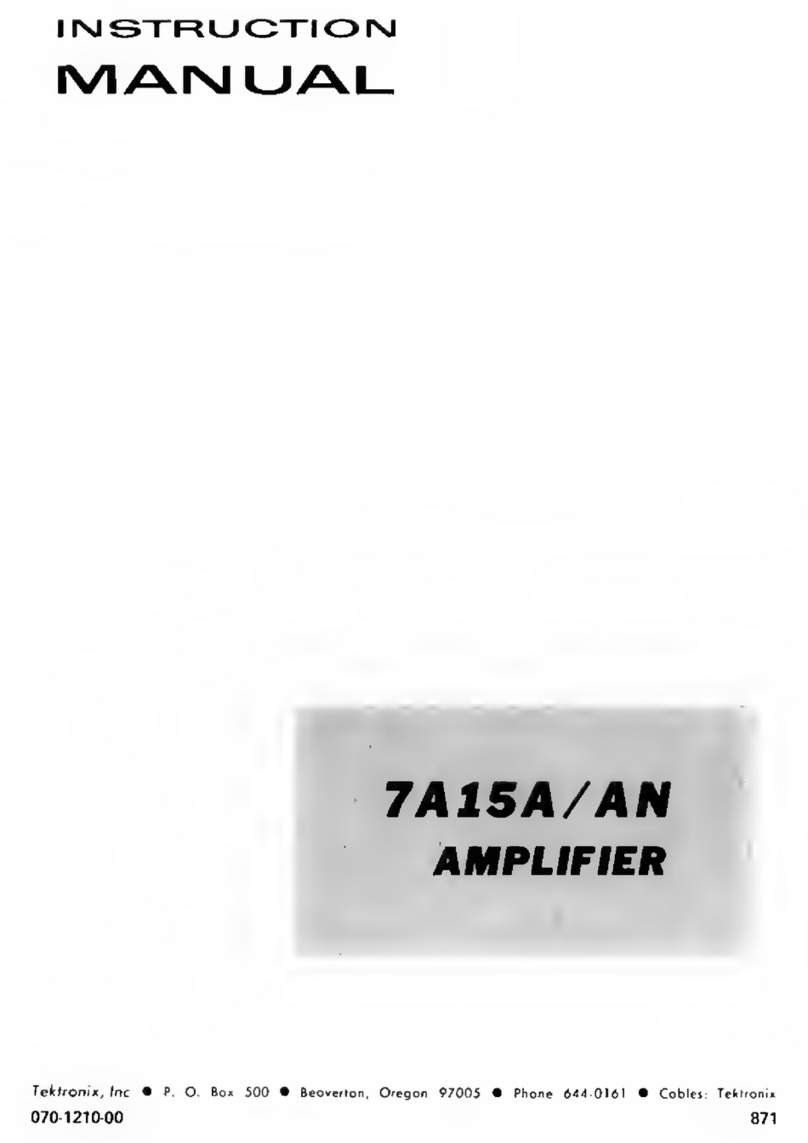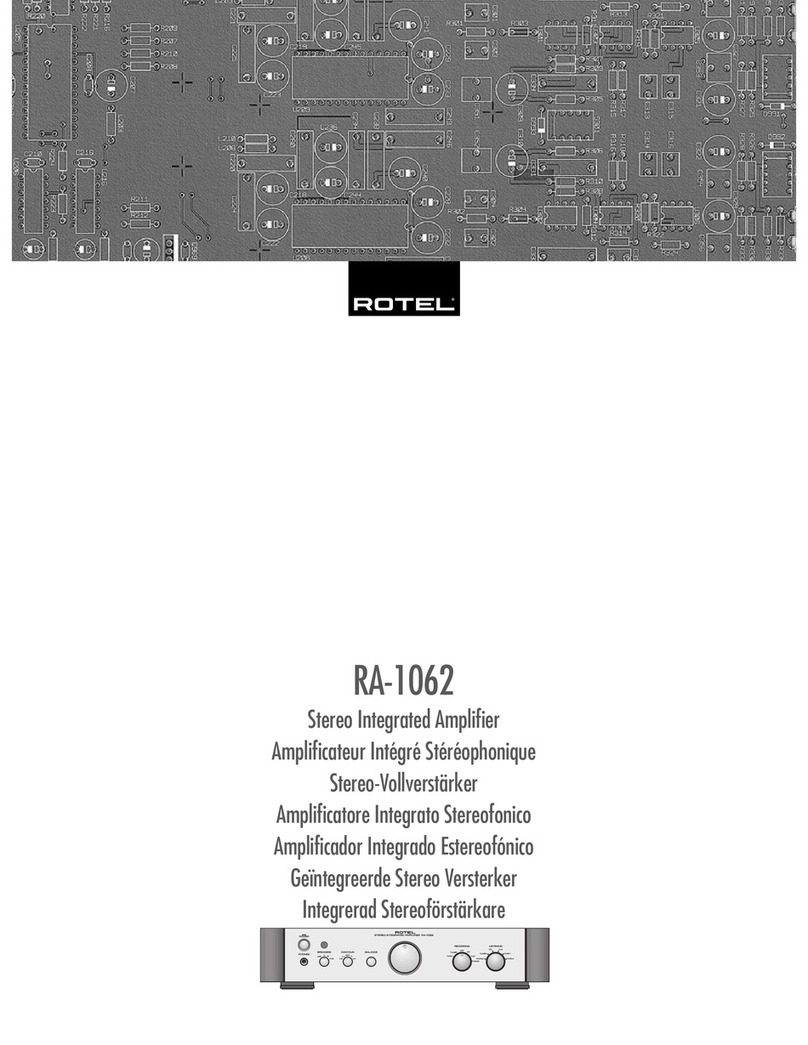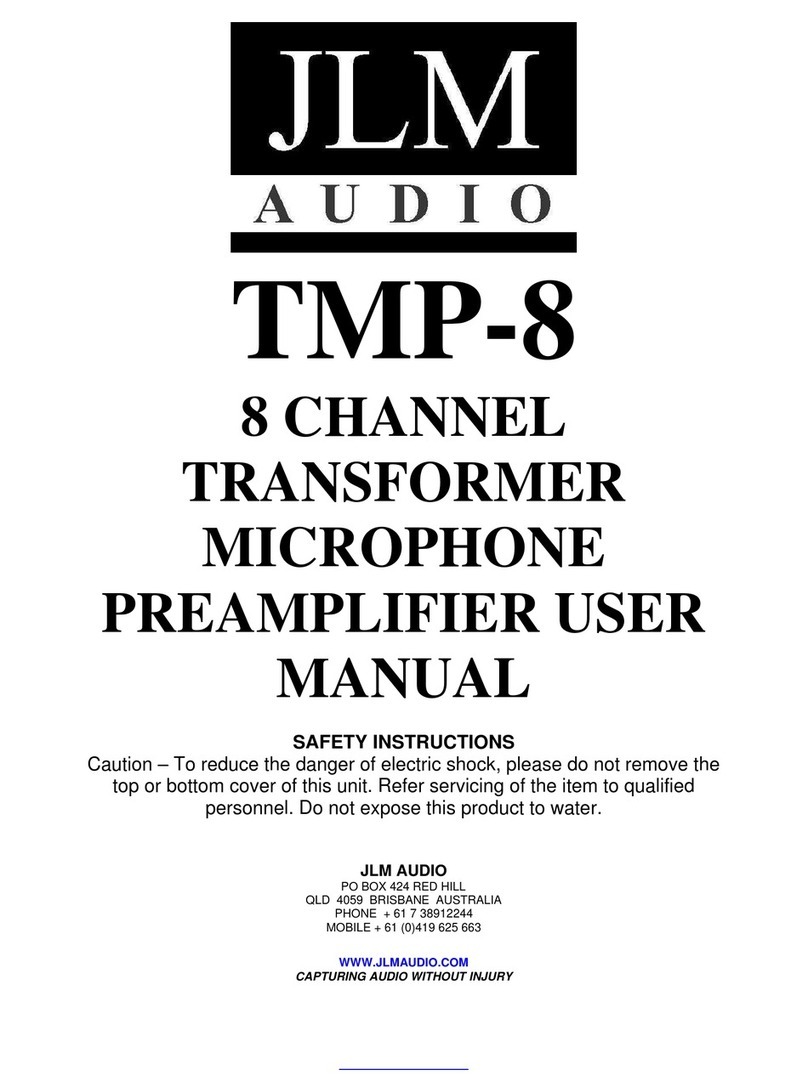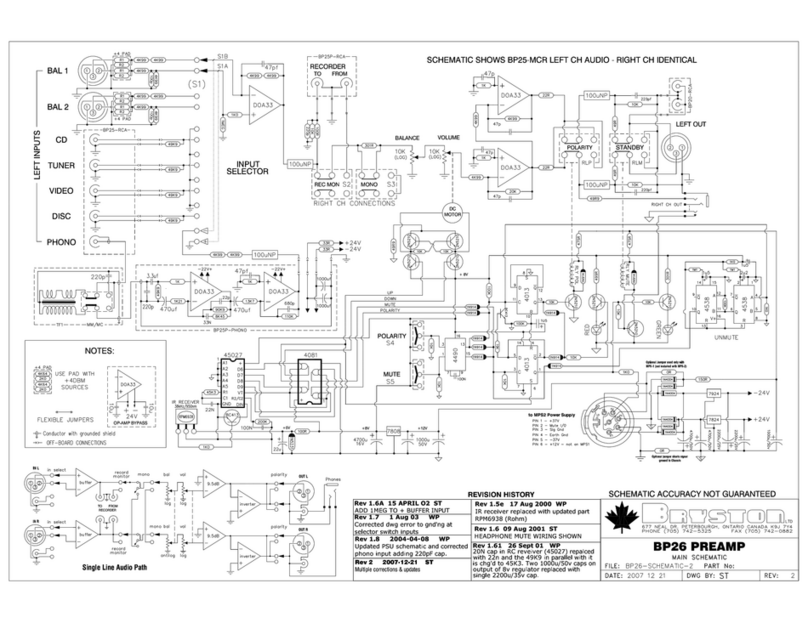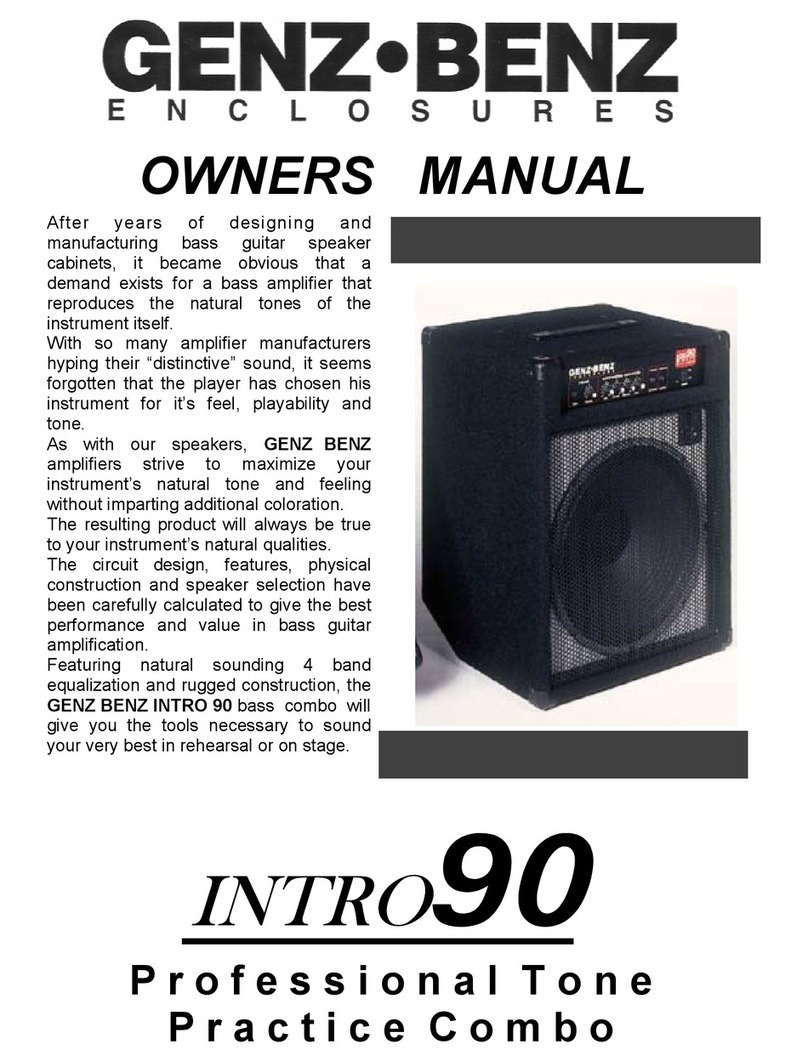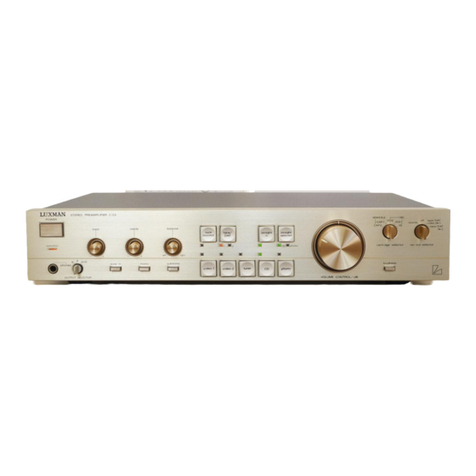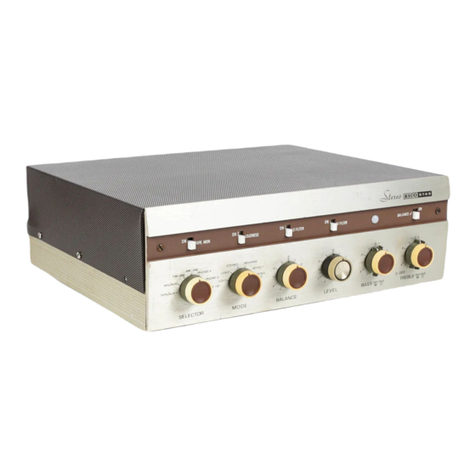Trinity Amps TriFly User manual

TrinityAmps TriFly PCB Builders Guide v1.docx
- 1 -
The Trinity Amps
TriFly
TriFlyTriFly
TriFly
PCB Builder's Guide
For the sole personal use of Trinity Amps Customers.
February 2017, Version 1.1
Parts © Trinity Amps 2005 2016
www.trinityamps.com

TrinityAmps TriFly PCB Builders Guide v1.docx
Page - 2 -

TrinityAmps TriFly PCB Builders Guide v1.docx
Page - 3 -
Table of Contents
Table of Contents ......................................................................................................................................................... 3
Introduction ................................................................................................................................................................... 6
Acknowledgements ....................................................................................................................................................... 6
WARNING ................................................................................................................................................................... 7
Please Read this Information Carefully ............................................................................................................. 7
Version Control ............................................................................................................................................................. 8
Product Overview and Specs ................................................................................................................................. 11
Guitar Amplifier Basics .............................................................................................................................................. 12
Distortion ................................................................................................................................................................. 13
General Amplifier Operation ................................................................................................................................ 15
Some DO NOTS .................................................................................................................................................... 15
Some DOs ................................................................................................................................................................ 15
Introduction to Vacuum Tubes and Common Terms .......................................................................................... 16
Introduction ............................................................................................................................................................. 19
Switches and wire .................................................................................................................................................... 19
Physical layout .......................................................................................................................................................... 19
Grounding ................................................................................................................................................................ 19
Insulated jacks .......................................................................................................................................................... 20
Minimizing transformer interference .................................................................................................................... 20
Wiring ........................................................................................................................................................................ 20
Assembling the amp ................................................................................................................................................... 21
Before You Begin .................................................................................................................................................... 21
Tools .......................................................................................................................................................................... 21
Soldering ................................................................................................................................................................... 21
Making a Voltage Measurement ............................................................................................................................ 22
Wiring ........................................................................................................................................................................ 23
Tube Pin Numbering .............................................................................................................................................. 23
Potentiometer Pin Numbering .............................................................................................................................. 23
Assembly Steps Summary .......................................................................................................................................... 24
1. Install Transformers ............................................................................................................................................... 24
2. Install IEC, Power Switch, Tube Sockets and Output Jacks ........................................................................... 25
3. Wire up and test the Power Transformer and Power Switch .......................................................................... 26
Grounding Scheme ................................................................................................................................................. 26
4. Build sub assemblies Volume Control and Input Jack ..................................................................................... 28
5. Build sub assembly Printer Circuit Board (PCB) ............................................................................................... 29
6. Install sub assembly PCB ...................................................................................................................................... 30
7. Install LED in V1 tube socket .............................................................................................................................. 31
8. Output Transformer Connection and Power Transformer Connection ....................................................... 31
9. Wire up the Heaters; Check Wiring ..................................................................................................................... 32
10. Start Up .................................................................................................................................................................. 34
Trinity TRIFLY Voltage Chart ................................................................................................................................. 36

TrinityAmps TriFly PCB Builders Guide v1.docx
Page - -
WARNING ................................................................................................................................................................. 36
Please Read this Information Carefully ........................................................................................................... 36
Troubleshooting .......................................................................................................................................................... 37
Hum ........................................................................................................................................................................... 37
Volume Test ............................................................................................................................................................. 37
Faulty tube ................................................................................................................................................................ 37
Severely unmatched output tubes in a push pull amplifier ............................................................................... 38
Faulty power supply filter caps .............................................................................................................................. 38
Faulty bias supply in fixed bias amplifiers ........................................................................................................... 39
Unbalanced or not ground referenced filament winding .................................................................................. 39
Defective input jack ................................................................................................................................................ 39
Poor AC grounding ................................................................................................................................................. 39
Induced hum ............................................................................................................................................................ 39
Poor internal wire routing ...................................................................................................................................... 39
Poor AC Chassis Ground at Power Transformer .............................................................................................. 40
Defective internal grounding ................................................................................................................................. 40
Hiss ............................................................................................................................................................................ 40
Metal Film Resistor Substitutions ......................................................................................................................... 40
Squealing/Feedback ................................................................................................................................................ 41
Radio Interference ................................................................................................................................................... 41
Scratchy Sounds on Potentiometer(s) .................................................................................................................. 41
Amp Buzz or Rattle When Installed in Cabinet ................................................................................................. 41
Appendix 1 Tone Tweaking ................................................................................................................................... 44
More Tips for fine tuning your amp ..................................................................................................................... 45
Appendix 2 How to read Resistor Color Codes .................................................................................................. 46
First the code ....................................................................................................................................................... 46
How to read the Color Code ............................................................................................................................ 46
Appendix 3 How to read Capacitor Codes .......................................................................................................... 47
Appendix 4 TriFly PCB Bill of Materials .............................................................................................................. 50
Appendix 5 FAQ ...................................................................................................................................................... 51

TrinityAmps TriFly PCB Builders Guide v1.docx
Page - 5 -
Thank You
Thank you for purchasing your TriFly kit from Trinity Amps. We truly hope that you enjoy
building it and that it will be enjoyed for many years. If you have any questions please do not
hesitate to contact us and. Please be sure to check the package contents in case there are any
missing items.
We are always looking for feedback form our Customers on our products. We have checked
the build instructions over thoroughly and are confident in our product. However, mistakes
do happen so our advice is that as you connect each wire and part according to the layout,
cross check against the schematic. If you find any inconsistencies, or have any concerns,
please let us know. Do not hesitate to contact us! We want this build to be successful for
you and for Trinity Amps!
We’re confident that you will like our product and our support and when you’re completed,
we’d appreciate your comments posted on any of the internet forums such as
thegearpage.net
, 18watt.com, AX84.com or trinityamps.com. You will find some extra
business cards in the package. Please keep one and pass the rest around.
We know you have a choice in suppliers and do appreciate your business. If there is any
other product we can provide to you or your associates, please get in touch and we will be
happy to discuss requirements.
Sincerely,
Stephen Cohrs,
Trinity Amps
Web site: www.trinityamps.com
email: stephen@trinityamps.com

TrinityAmps TriFly PCB Builders Guide v1.docx
Page - 6 -
ntroduction
This guide has been prepared for builders of Trinity Amps Kits. It is always being improved
and we would appreciate your feedback and comments to:
stephen@trinityamps.com
Accordingly, content and specifications are subject to change without notice.
We do try to make it as accurate as possible, but it is sometimes hard to keep up with the
changes. Therefore, if you do find an error, please let us know about it and we will correct it.
Suggestions are welcome so if you have one, please get in touch with us.
Sources of help.
Forums: Please use the various forums to get help. They are an excellent resource and can
be found at trinityamps.com, AX84.com, the Gear Page etc..
Color assembly pictures and the latest drawings, tips, techniques are all in the Trinity Amps
Forum, in the Resources Forum. To view the Resources, you need to sign up so go to
www.trinityamps.com
and click on the Forum button.
Email: We can’t help with every problem but if you can not get your problem resolved, email
us and we’ll do our best to help.
Phone Call: If your problem can’t be solved, email for a phone appointment.
Acknowledgements
Much of the content in this document is original. Rather than reinvent content, some parts
are based on content from other excellent sources and are hereby acknowledged.
R.G. Keen’s site
www.geofex.com
Tube Amp FAQ, Tube Amp Debugging
AX84.com site
www.AX84.com
Gary Anwyl's P1 construction guide version 1.0
GM Arts website
http://users.chariot.net.au/~gmarts/index.html
Guitar Amp
Basics
www.18watt.com
website for various content and diagrams – Richie TMB
Aron from diystompboxes.com
Parts © Trinity Amps 2005. No part of this document may be copied or reprinted without
written permission of Trinity Amps or contributing authors listed above.

TrinityAmps TriFly PCB Builders Guide v1.docx
Page - 7 -
WARN NG
Please Read this Information Carefully
The projects described in these pages utilize POTENT ALLY FATAL H GH
VOLTAGES. If you are in any way unfamiliar with high voltage circuits or are
uncomfortable working around high voltages, DO NOT R SK YOUR L FE BY
BU LD NG THEM. Seek help from a competent technician before building any
unfamiliar electronics circuit. While efforts are made to ensure accuracy of these circuits, no
guarantee is provided, of any kind!
USE AT YOUR OWN RISK: TRINITY AMPS EXPRESSLY DISCLAIM ALL LIABILITY FOR
INJURY OR PROPERTY DAMAGE RESULTING FROM THIS INFORMATION! ALL
INFORMATION IS PROVIDED 'AS-IS' AND WITHOUT WARRANTY OF ANY KIND
REMEMBER: NEVER OPERATE YOUR AMP W THOUT A LOAD. YOU
W LL RU N YOUR OUTPUT TRANSFORMER!

TrinityAmps TriFly PCB Builders Guide v1.docx
Page - 8 -
Version Control
Version Date Change
1.0 28Dec16 First release
1.1 1Feb17 Clarified input jack wiring

TrinityAmps TriFly PCB Builders Guide v1.docx
Page - 9 -

TrinityAmps TriFly PCB Builders Guide v1.docx
Page - 10 -
TriFly Description
The design of the TriFly began with an inspiring customer call "Please make me a small,
higher gain amp that I can play but that my ears can tolerate".. His ears were suffering from
an illness and he could not withstand any loud sounds. Yet he still wanted to play his guitar
like his old JCM 800 .
So the research began. Our design criteria were:
low and high gain modes but not too loud.
cost effective iron and parts
compact
minimal controls (possible tone control by the guitar tone).
Printed Circuit Board manufacture an option.
Able to use it in our Amp Camp Training program – build it in a day.
use traditional power supply not complicated circuitry.
use readily available off the shelf tubes such as 12AX7s.
We did a lot of research and in doing so, learned about the Phillips Self Split design which
eliminates the need for a Phase Inverter (PI). It is less efficient than a true Push Pull design
but would help meet our design goals. It was invented by Phillips and was used in some
budget amps of the day.
We also learned about a public domain amp called the Firefly that used this concept and
since we had all the parts, that became our first attempt at a low power amp.
The final design while unique retains some of the Firefly heritage. Once again we settled on
a Heyboer output transformer since in studio listening tests it proved the best. Surprisingly,
the output tube we chose was a 12BH7 rather than the expected ECC99 because he tone
was more like a Marshall. While we tried various preamp tubes, we did settle on the
ubiquitous and readily available 12AX7. We tried a tone control that was quite uncommon
and was used in Gibson and Garnet amps. It was a low loss control that at extremes subtly
boosts treble and gain or filters out treble. We also tried a Master Volume. In the end, we
went with ONE knob since most of the testers thought it was perfect that way. . So the
current design has Power, Volume and Input on the front panel.
We spent several hours in the SlyFi Chapel studio. Shawn Dore played while settings were
changed, tweaked, recorded, commented. We noted that the TriFly takes pedals so well; you
can get pretty well anything you want out of the TriFly. And we know players who like
pedals! If you want over the top distortion, this is the way to go.
After all was said and done, everyone agreed the TriFly was ready for prime time!! It really
shone and the best example was when using the Ash body Tele, on the neck pick up. Under

TrinityAmps TriFly PCB Builders Guide v1.docx
Page - 11 -
the vast majority of situations, this arrangement would be very hard to listen to, yet the
TriFly made it sound nice! With the Gretsch Country Gentlemen you could hear the detail
of the hollow body in the sound. it was quite glorious!
We were aiming for a great tone at a low power in a compact package and we definitely
achieved that.
Product Overview and Specs
The TriFly is a one channel input with a single Volume control.
12AX7 Preamp tube.
12BH7 dual Triode high current
Power tube, in self split push pull mode , running a little “hot” to deliver more symmetrical
clipping.
The 12BH7 sounded like a Marshall which was a BIG surprise. It had better dynamics and
feel but a little less headroom in a good way. An ECC99 can be substituted if desired.
Self Split drive design is an arrangement where the power tubes also function as it’s own
Phase Invertor. The first triode drives the second one through the common cathode
connection.
Volume sets the overall listening level.
Heyboer M 27 steel output transformer with 4,8 and 16 (unused) ohm taps. This
transformer gave the TriFly an excellent bottom end with a thicker sound and also it had
fantastic clean tone at low levels.
A Conjunctive filter is incorporated into the output stage to tame some fizz and smooth out
the response.
The eyelet board / PCB for the TriFly is a new approach. Wanting to keep this design
compact, we went for a layout that located the tubes in the middle of the chassis with holes
through to feed the components directly to the tube pins and we used regular tube sockets.
The tubes are aligned so the heater connections are closest to each other. This is a very
compact and very quiet design!

TrinityAmps TriFly PCB Builders Guide v1.docx
Page - 12 -
Guitar Amplifier Basics
Electric guitarists can be fairly criticized for their reluctance to change to new ideas
and technologies; however, there is no doubt that a classic 1950’s guitar and tube
amplifier in good condition still sounds great in modern recordings. This is a
testament to good design from the start. What has improved today is consistency,
and the cost benefits of production line manufacturing. This is offset by the rarity of
good guitar wood (it makes a huge difference, even on an electric guitar), increased
labour costs for both guitars and amplification equipment, and the availability of good
and consistent quality tubes.
There is also an element of nostalgia, with memories of many of the great players of
years gone by, and the desire to use the same types of instruments and equipment to
recapture the magic. Vintage instruments and equipment have also become valuable
collectors items (some with very inflated prices) which adds further to the desirability
of older tools of the trade. There has been a recent trend by many companies to re
market their original instruments and equipment; new guitars can even be bought now
‘pre aged’!
This desire for vintage equipment is also related to guitarists’ reluctance to part with
tube amplification, and there are many reasons why tube and solid state amplifiers
behave differently. Quite simply, if players prefer the sound of tubes, they will
continue to buy and use them. Below are some fundamentals.
nput mpedance
Typically 1M, 500K minimum (humbucking pickup guitars
have volume pots up to 500K, single coil pickup guitars typically of 250K) .
Tone Controls
Magnetic guitar pickups are inductive, and require
compensation, although this opportunity is also used for tone enhancement, not just
correction. Without compensation, they have a strong low middle emphasis and
little high frequency response overall a very muddy and muffled sound. This is
why typical hi fi Baxandall treble & bass controls are unsuitable.
To hear the natural sound of a pickup, use a typical guitar amp with the middle set to
full, and bass and treble on 0. This is actually sets a flat response in the amp (see
below). Expect to hear a muffled and muddy sound. And that's the whole point of
these tone controls providing compensation for the natural sound of a pickup the
middle control simply boosts the pickup's normal ‘middley’ sound. The treble and
bass controls do the opposite they boost higher and lower frequency levels, leaving

TrinityAmps TriFly PCB Builders Guide v1.docx
Page - 13 -
a notch in between for middle cut (see the Fender/Marshall comparison below). So
with typical settings of a bit of bass, middle and treble, the overall tone equalization
complements the natural pickup sound for a balanced response of lows, mids and
highs.
Distortion
The overdriven sound of a tube power amplifier is highly desirable, with many different
output stage designs to produce the variety of trademark sounds heard on modern
recordings. The only problem is that a tube power amplifier is only capable of producing
this sound at one volume (usually, fairly loud!).
There are probably 3 distinctly identifiable types of tube power amplifiers used:
Leo Fender's classic early designs used 6V6 tubes, and later, the higher powered 6L6's. This
gave a characteristic full and punchy sound, suitable for many styles of the day, and later.
Steel and country players like the chime like clean sounds, and blues players were quick to
discover the classic way it breaks up when pushed hard. At really high overdrive, though,
the sound becomes quite dirty, with bass in particular sounding flabby.
Marshall designs started as Fender copies, but soon switched to EL34 output tubes, possibly
for local supply reasons. Anyway, the rest is history. These tubes exhibit a softer overdrive
transition, and maintain clarity even at high overdrive levels. They also have a limited
middle response, giving rise to the famous Marshall crunch sound. The lower powered
EL84 tubes have similar characteristics.
Vox AC30 (and the more popular top boost model) uses a Class AB power amplifier design,
with the tubes biased ‘hot’, so while this operates in class A at lower levels, it is a class AB
design. There's no negative feedback in the power amp either, so this gives a different
sound, often described as a sweeter overdrive. Listen to Brian May's sounds for plenty of
good examples.
The Fender and Marshall designs use class AB for their output designs, biased with the
tubes almost off with no signal. This is more efficient (more watts per tube), and better for
tube life. When you play, tubes take turns handling each half of the signal. This leads to
some (unwanted) distortion as the tubes cross over. Class A designs are rare in medium to
high power guitar amps, but true class A has the tubes operating at half power, with no
signal applied. When you play, the tube fluctuates between full and no power, so there is no
switching to add unwanted distortion. This is a very superficial explanation; please read
elsewhere on the Internet for more detailed descriptions.
Wide Dynamic Range
A plucked guitar string requires a wide dynamic range
to handle the initial peak, and then cleanly amplify the decaying string
vibrations. Some poor designs do not have this capability in their preamp stages, let
alone the power amp to handle this. Pre amplifier stages need generous power rails,

TrinityAmps TriFly PCB Builders Guide v1.docx
Page - 1 -
and should not have gain stages which cause the initial plucked part of the string
sustain envelope to be clipped.
nstrument Speakers
Unlike hi fi speakers, which are designed to keep the
coil entirely within the magnetic field to maximize linearity, instrument speakers are
designed to have the coil partially leave the magnetic field at the extremes of cone
travel. This is partly to protect the speaker, but also produces a ‘soft clipping’ effect
which is desirable with guitar amplifiers. It is also therefore important to match
speaker power ratings reasonably closely with the power of the amplifier. Popular
instrument speakers are available from Tone Tubby, Celestion, Jensen and others.
Note: If you were to use two cabinets hooked directly into the amp, be sure to set
the amp at half the impedance of the cabinets. For example, if your cabinets are 8
ohms each, set the impedance selector to 4 ohms.
Durability
Most musical styles will require the amplifier to be overdriven for
extended periods of time, and the amplifier must be designed to provide this without
duress on any components. Common non guitar design principles assume that
circuitry will be designed to avoid overdrive, and technicians working in this field
have to ‘un learn’ many basic assumptions. Popular circuits have evolved through
trial and error, due to a general lack of documented knowledge in the field of non
linear amplification.
Road Worthiness
Musical equipment of this type needs both physical and
electrical protection. A band often has its equipment transported and set up by a
road crew with little guarantee of physical care. Likewise, an assumption should be
made that the output stage will at times be inadvertently shorted, so most
professional equipment is designed to handle this contingency, preferably
electronically, and at the very least without fuses inside the chassis.

TrinityAmps TriFly PCB Builders Guide v1.docx
Page - 15 -
General Amplifier Operation
Some DO NOTS
•
Never, Never, Never run the amp without a speaker plugged in.
This can cause
major damage.
• Do not flip the power switch off, and then back on rapidly. This can cause
power supply damage.
• Never replace a burned out fuse with a bigger amperage one. Remember
there was a reason the first one burned out, usually protecting something
more expensive. Putting a bigger fuse in will just ratchet up the power level
until something really vital burns out. If the second equal rating fuse pops,
turn it off and get a tech to look at it.
• Never ignore signs of high heat inside a wisp of smoke or a burning smell is
NOT normal.
• Your amp produces lots of heat, and will continue to do so even if you block
the fresh air vents. Blocking the vents will overheat the amp and you may
have to get some very expensive repairs done.
• Never ignore a red glow other than the small orange ends of the filaments. A
red glow over a large part of the internal plates of the output tubes means
they're about to melt. If you notice this, shut it down and get a tech to help
you find out what is wrong.
Some DOs
Add another speaker into the "external speaker" jack; a mismatched speaker load
won't kill it, while an open circuit (disconnected speakers) may do so.
Overdrive the stuffing out of it. Tubes are very forgiving of massive overdrives,
unlike solid state gear. As long as they tubes don't overheat for long periods, it's not
fatal.

TrinityAmps TriFly PCB Builders Guide v1.docx
- 16 -
ntroduction to Vacuum Tubes and Common Terms
Reprinted with permission from Aron from diystompboxes.com
Here are a few terms that you may see online when referencing tube schematics. Like distortion
pedals, tube circuits seemingly have their own language! I present this knowledge in the hopes that
it may help you decipher the interesting life of tubes! : ) Below, is a picture and a very simplistic
view of a tube stage.
As you can see above, in this tiny snippet
of a tube schematic, the terms you commonly see are there in this triode stage example.
Plate the plate is usually connected to a plate resistor which is usually connected to the B+ or
power supply voltage. Typical Plate Resistor values are 100K, 150K, 220K. Larger values equal
more gain.
The Grid is where the signal enters the tube.
The Cathode is usually connected to a cathode resistor which usually goes to ground. The cathode
resistor, along with the Plate resistor, control the gain of the tube stage. Typical values are
anywhere from 100 ohms to 10K. Smaller values = more gain.
It is common to see a cathode bypass cap connected in parallel with the cathode resistor. By
altering the values of the cathode resistor and cathode bypass cap, it is possible to roll off various
degrees of bass with this triode stage. The cathode resistor and plate resistor control the biasing of
the tube. The cathode bypass cap also gives the stage more gain.
Sometimes you see a capacitor in parallel with the plate resistor, much like the cathode resistor
bypass cap. It is usually a small value (i.e. .001uF) and it rolls off highs in the stage. Sometimes you
see a high frequency roll off cap going from the plate pin to the cathode pin 350pf >500pf in
value.

TriFly PCB Builders Guide Version 1.0 Page 17
You will also see a coupling cap in
between triode stages. The coupling cap controls the bass and rolls off bass between stages and
blocks DC from entering the next stage which could throw off the bias on the next tube stage.
As usual, smaller values roll off more bass, larger values retain more bass between stages.
Another modification you may see is a Grid Stopper Resistor, this can also control gain between
stages and also interacts with the tube to roll off highs. Values can be 1.5K >100K. Larger values
roll off more highs and reduce gain between stages. The Grid Stopper Resistor works best when
mounted directly or as close as possible to the grid pin.
"Complete" typical tube preamp stage:

TriFly PCB Builders Guide Version 1.0 Page 18
The grid ("leak") resistor, typically sets the impedance of the stage and biasing. It is interesting
because it and the previous stage's plate resistor form a voltage divider on the signal. What this
means to you is that the grid leak resistor can be used to control the level into the stage. Low grid
leak values will attenuate the signal into the tube stage. If you look at different tube amp
schematics, you can see where they control the level into the stage by using different values for the
grid leak resistor. There is a maximum value that you need to adhere to. Check the datasheet for
the tube you are using to see the typical value of the grid leak resistor. This particular circuit is
called cathode bias which you can read about here.
In summary, the cathode resistor, plate resistor and grid resistor, determine the biasing of the tube
stage. The cathode bypass cap controls the degree of bass reduction generally 25uF passes all
frequencies commonly used in Fender amps, 1uF an 0.68uF are used in Marshall amps. A
capacitor can be placed in parallel with the plate resistor to roll off highs and you see this in bass
channels of amps sometimes. The plate receives the voltage from the power supply through a plate
resistor, the grid receives the AC signal as input and the cathode is grounded through a cathode
resistor.

TriFly PCB Builders Guide Version 1.0 Page 19
Building an Amp
Warning: Do not attempt to build a guitar amp unless you know how to work safely with the
dangerous voltages present in a tube amp. These can exceed 700 volts.
ntroduction
If you have purchased your Trinity Amp as a kit, this guide will help you build a tube guitar
amplifier. It is oriented towards someone who knows a little about electronics but is new to do it
yourself amps. It outlines a simple path to getting a quality amp build.
Switches and wire
Use standard UL approved switches with a 125V/3A rating for the Power and Standby switches.
Use 20 or 22 Gauge insulated solid wire with a 600V rating. It is good to get a variety of colors so
you can color code your wiring.
Physical layout
Make sure the jacks, sockets and pots mounted along the edge won't interfere with parts mounted
on the underside of the chassis. Imagine how chassis will be mounted in the cabinet and make sure
there is enough clearance for the speaker and mounting brackets. Trinity amp chassis are laid out
with serviceability and neatness in mind.
Grounding
It is recommended that you follow the layout provided with your Trinity Amp. It has been tested
and has proven reliable. If you choose to deviate, consider the following information.
Amps traditionally use the chassis for signal ground. This is not the best choice since it can create
ground loops and bad ground connections may develop over time. It is better to use star
grounding in which all of the local grounds are collected at a single ‘star ground’ point. With star
grounding there is only one connection between the chassis and signal ground.
Here are some rules for laying out a star ground. More information on grounding can be found in
the Tube Amp FAQ and the Tech Info page of Aiken Amplification.
(1) Connect the power transformer center tap directly to the negative terminal of the first power
supply filter capacitor (cap) then run a separate wire from the negative terminal to the star ground
point.
(2) Collect the ground points of each tube and its associated resistors and capacitors to a local
ground point that is not connected to the chassis. Run one wire to the star ground point from each
collection.
(3) Run exactly one wire from the star ground point to chassis.
(4) Insulate the input and output jacks from the chassis.

TriFly PCB Builders Guide Version 1.0 Page 20
The safety ground wire from the mains is separate from the signal ground. Run a wire from the
AC ground to the chassis near where the AC power enters the chassis.
nsulated jacks
To insulate the input and output jacks either use plastic insulated jacks or metal jacks with
insulating washers. Some people prefer the increased durability of metal jacks. Insulating a metal
jack requires a shoulder washer with a 3/8’ internal hole that fits a ½’ panel hole.
Minimizing transformer interference
To minimize coupling between the power transformer and output transformer orient them so their
plates are at right angles. If possible, place them at opposite ends of the chassis.
Keep the input stage wiring short and away from the output stages. This minimizes the possibility
of oscillations caused by coupling of the output signal into the input.
Mount the grid resistors as physically close to the grid pins as possible.
Use a twisted pair of wires for the tube filament wiring. Route it away from AC lines and close to
the chassis.
Wiring
The traditional method of constructing amps involved mounting the components on tag board or
fiberboard. This is the technique that is used for Trinity Amplifiers and is the recommended
approach for service and reliability.
Table of contents
Other Trinity Amps Amplifier manuals
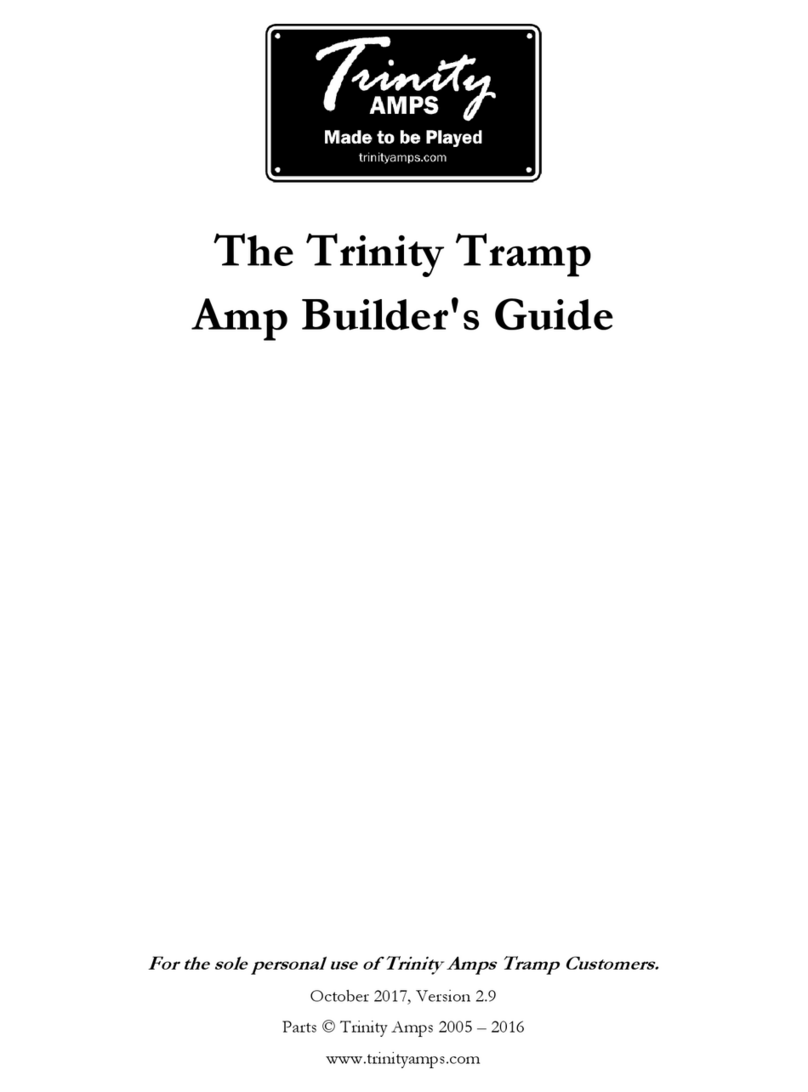
Trinity Amps
Trinity Amps Tramp User manual
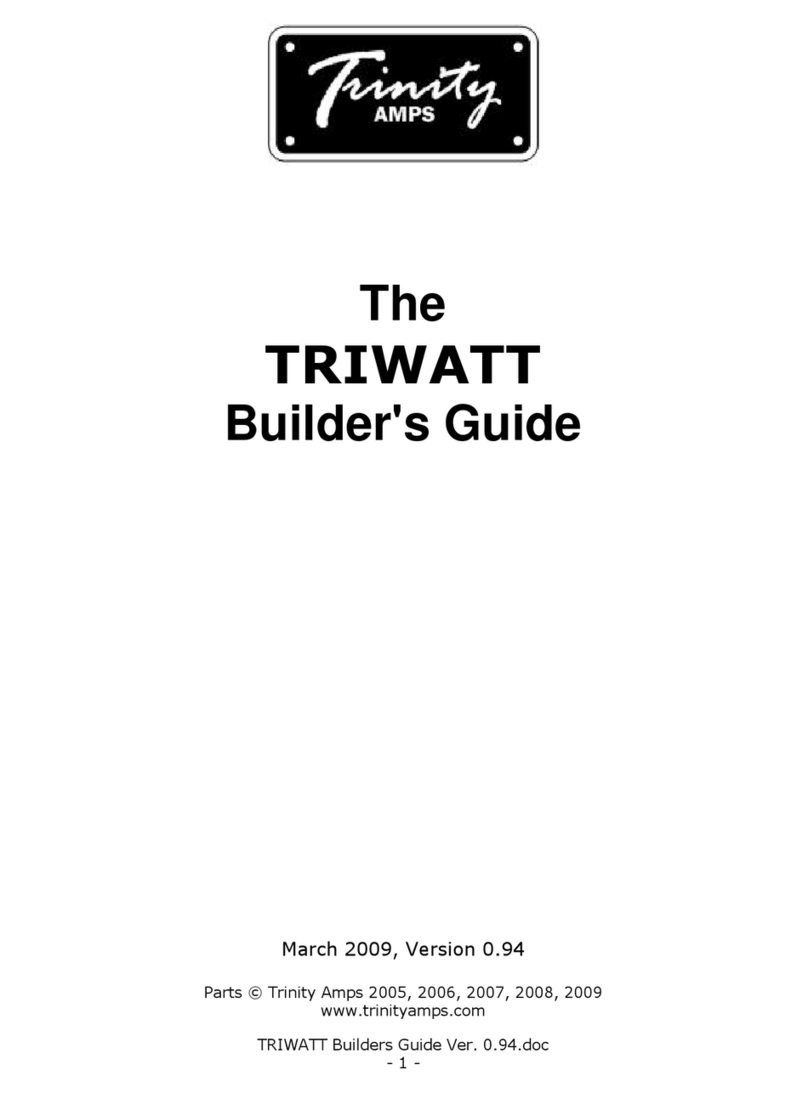
Trinity Amps
Trinity Amps TRIWATT User manual

Trinity Amps
Trinity Amps Tube Effects Loop User manual

Trinity Amps
Trinity Amps TRIP TOP User manual
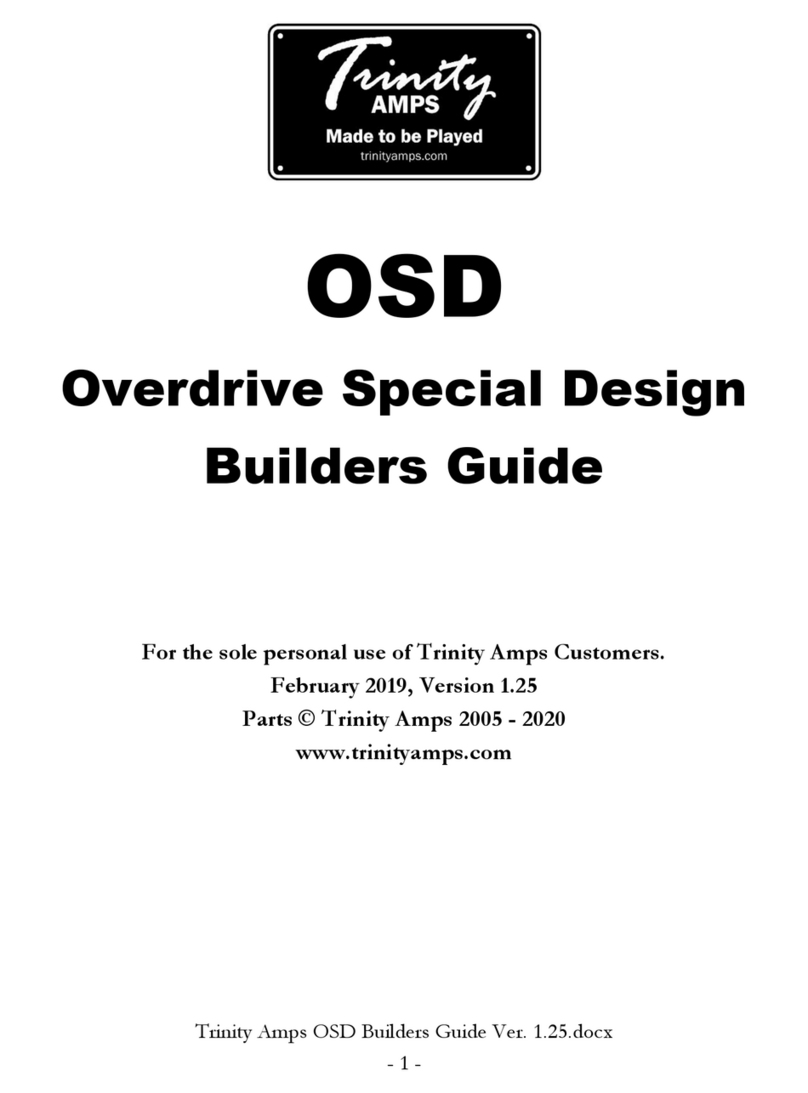
Trinity Amps
Trinity Amps OSD User manual
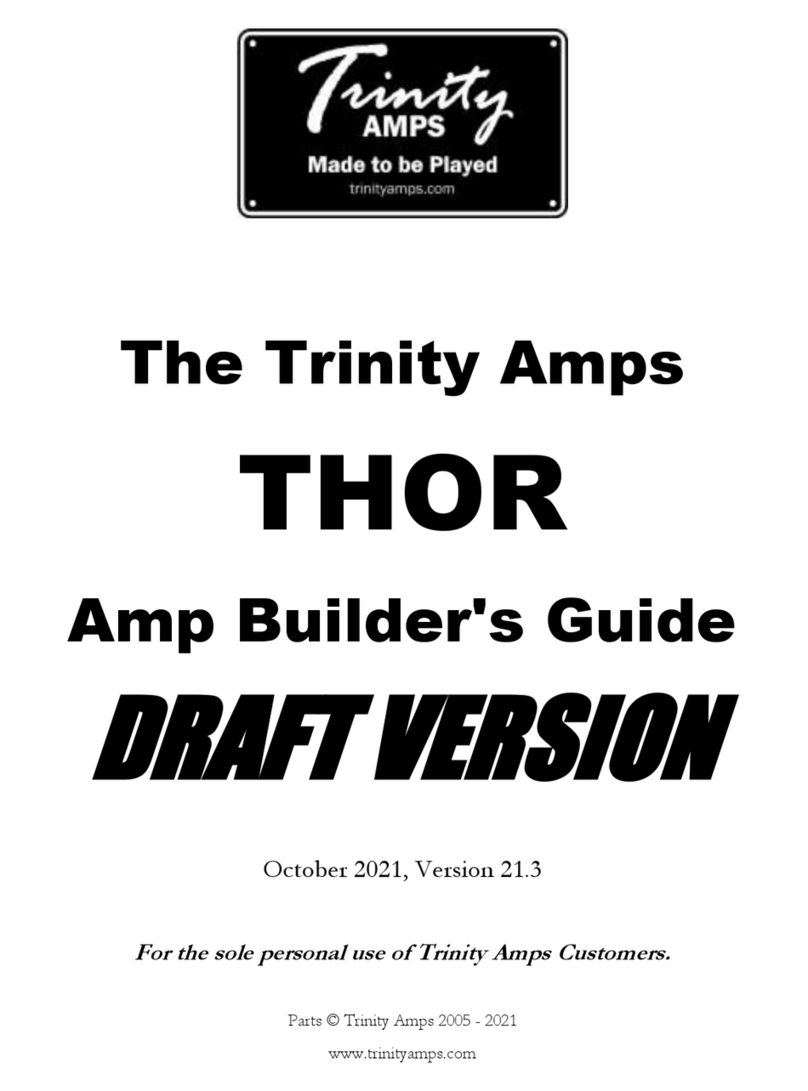
Trinity Amps
Trinity Amps THOR User manual
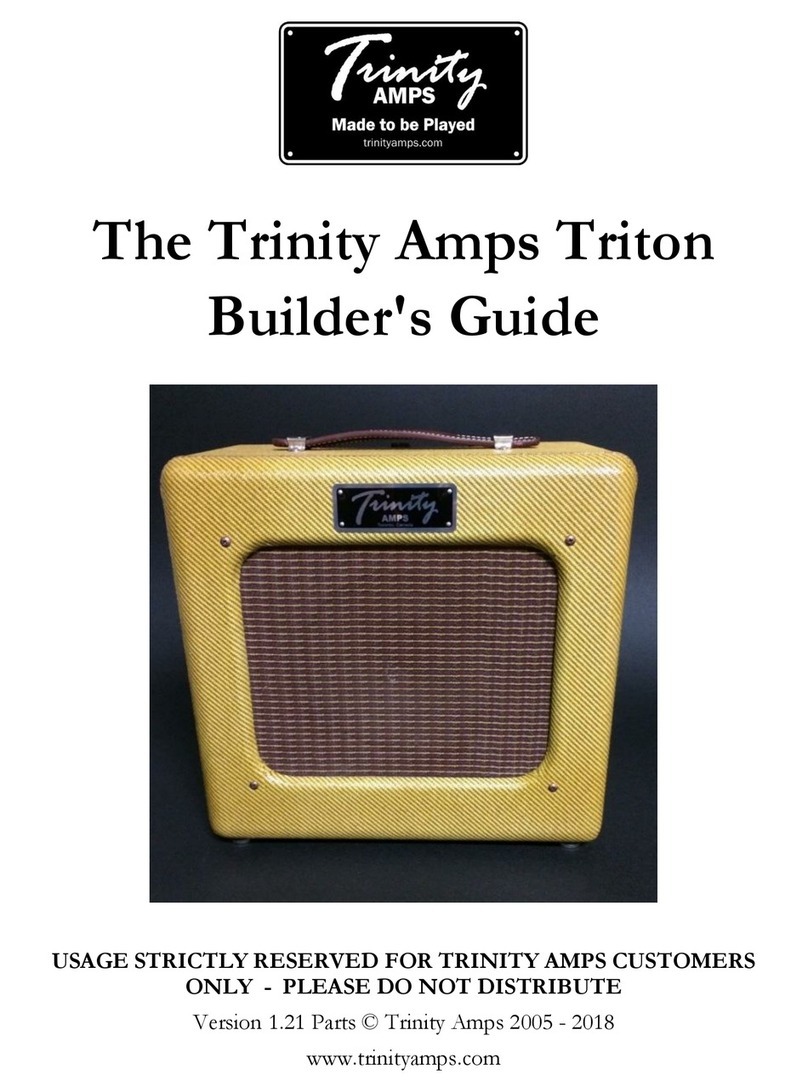
Trinity Amps
Trinity Amps Triton User manual
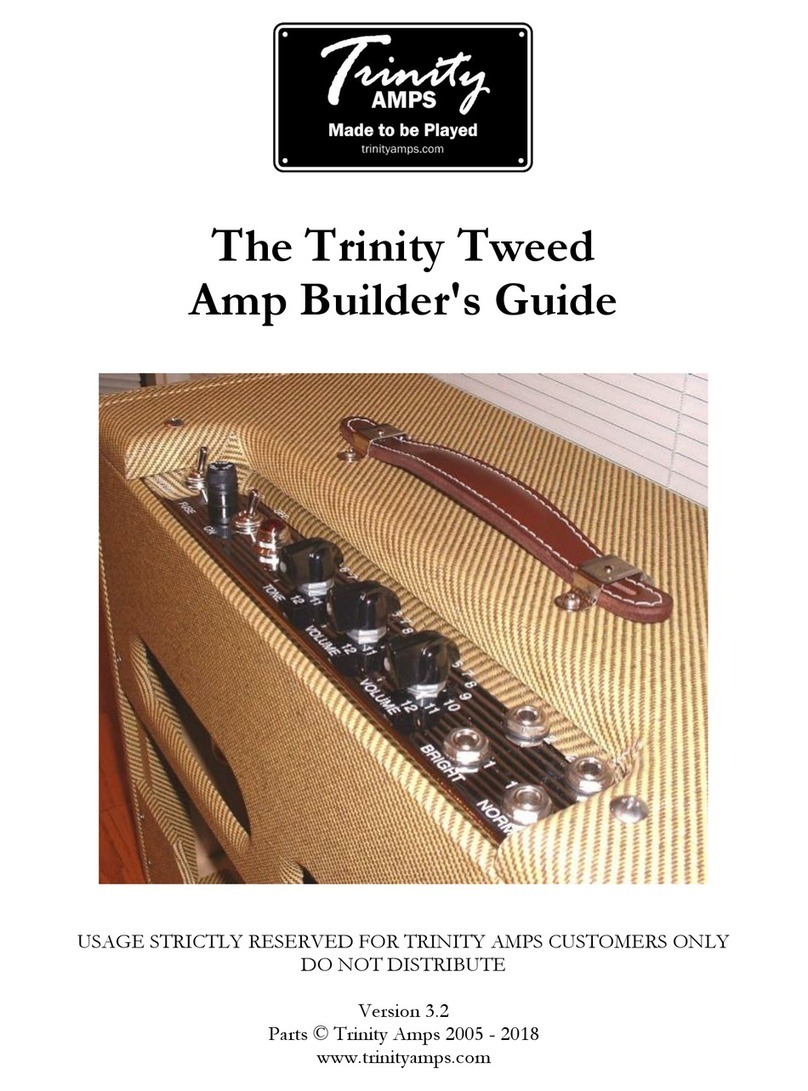
Trinity Amps
Trinity Amps Trinity Tweed Amp User manual
